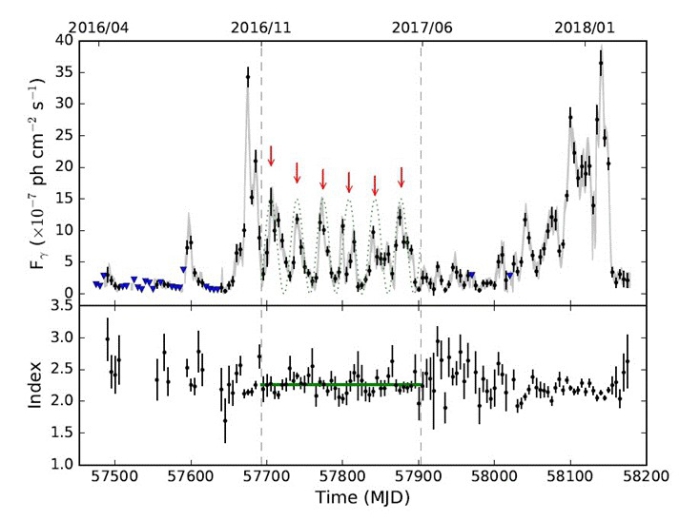Supposing a distant active black hole is vomiting towards you, what will you see?
Recently, a research group led by Prof. WANG Zhongxiang from Shanghai Astronomical Observatory discovered a month-long Quasi-Periodic Oscillation (QPO) from such a black hole. This is the only QPO in gamma ray ever found by the Fermi Gamma-ray Space Telescope. This work has been published in Nature Communications recently.
For most large galaxies, a gigantic black hole sit at the very center. When they are munching on gas and stars, they are in the active state. Approximately 10% of AGN are found to have a jet, launched from the immediate vicinity of the SMBHs. When such a jet happens to be pointing close to the line of sight, the light from the jet will dominate. Such AGNs are classified as blazars.
Multi-wavelength monitoring observations of AGNs have revealed one type of peculiar phenomenon called the Quasi-Periodic Oscillations (QPOs); i.e., at some wavelengths the AGN brightens and dims periodically.
QPOs with timescales of years may indicate that there is a binary black hole system in the center. QPOs with timescales of days may indicate that the phenomenon happening around the innermost stable orbit of a black hole.
Recently, based on the gamma-ray data obtained with the Fermi Gamma-ray Space Telescope, one research group at SHAO led by Prof. WANG Zhongxiang have found a 34.5 day QPO in emission from a blazar named PKS 2247-131, 3.6 billion light-years away from the Earth.
“This blazar started to have a bright gamma-ray flare since 2016 October. After its flaring flux peak, a 34.5 day periodic modulation is clearly seen in its light curve.” Said the first author Dr. ZHOU Jia-Neng.

Fig. 1: The light curve of the blazer PKS 2247-131. Image Credit: ZHOU et al. 2018.
“It’s very rare to see such a clear case of a month-long gamma-ray QPO. We have looked over 1800 blazars observed by Fermi, but only this one is found”, added Prof. WANG Zhongxiang.
“We find that during the QPO time period, the emission properties have been stable without significant physical changes. It indicate that the QPO is likely due to a geometric effect.” Said Dr. CHEN Liang.
He said, the jet in this blazar probably has a helical structure. Since our viewing angle to the jet’s emission undergoes periodic changes, the observed brightness will be quasi-periodically modulated.